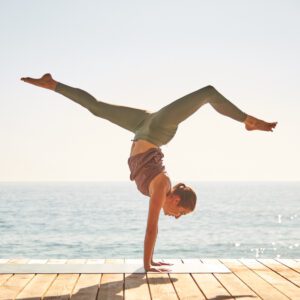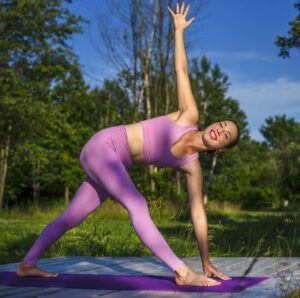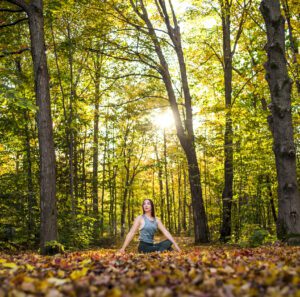
Ottawa-based Yin and Vinyasa Yoga Instructor, YouTuber, author, and the face behind Yoga with Kassandra, Kassandra Reinhardt is on a mission to help others feel great with yoga.
As one of the first yoga instructors to embrace online teaching, her Yoga with Kassandra YouTube channel has grown to more than 1.9 million subscribers and has over 190 million views. She specializes in her bitesize approach of 10-minute morning classes as well as videos featuring yoga for athletes, morning yoga, Yin Yoga for your nervous system (combating burnout), mental health & emotional healing.
Kassandra is the author of “Yin Yoga: Stretch The Mindful Way” (DK Books), has led yoga retreats internationally, and offers online workshops and in-person Yin Yoga training. She is also the creator of the Yoga with Kassandra app, a source for yoga with exclusive video content, journaling features, and more.
With over 2 million people in her online community, Kassandra has truly provided accessibility to yoga and she is expanding her expertise further, with the release of her second book, “Year of Yoga: Rituals for every day and every season” (Mandala Publishing, out June 7th). “Year of Yoga” includes holistic practices for any level student, coinciding with affirmations that illuminate the beauty and possibility each of the four seasons presents. Kassandra and her channel have been featured in CBC, Bustle, PopSugar, Well+Good, and Elle Australia.
Find Kassandra on www.yogawithkassandra.com.
INTERVIEW TRANSCRIPT
KIMBERLY MASKA: All right, everybody. Welcome. Welcome to you. Spiritual Business Magazine. We are here today with Kassandra Reinhardt. She is the cover for this month, and she is here to share her story about her journey in setting up and creating her spiritual business. That’s having a major impact out there. And I know Kassandra, you have a YouTube channel now that is Yoga with Kassandra. That’s almost 2 million followers on that now, is that right? That’s amazing!
KASSANDRA REINHARDT: Thank you! We actually just reached 2 million yesterday.
KIMBERLY: Wow, fantastic! I’m glad we’re here to join and to celebrate that with you. Tell everybody a bit about your journey and how you got here and how yoga became your passion and you really followed that path.
KASSANDRA: Yeah, of course. So, thanks for having me. I was introduced to yoga when I was about 18 years old. I came from the world of dance and grew up doing dance, ballet, all of that. And I just went into a few drop-in classes, yoga classes, very casually. I was just looking for something to help compliment my dancing, to help make me a little stronger, a little bit more flexible, to help maybe a little bit with stress relief. And I can’t say that I necessarily fell in love with yoga right away when I tried it. I liked it. I kept showing up, but it wasn’t until I found the right teacher and the right style for me, that things kind of shifted and connected. And I ended up pretty much leaving the world of dance.
My body was a wreck at that point. I had a lot of issues. I was so young, 18 or 19, but I already had so many issues with my knees, my lower back, my hips. I was in a lot of pain, and mentally I was not doing well. I was really hard on myself. I’ve always been someone who’s been quite hard on myself and had a lot of anxiety. So when I found yoga, all of a sudden I was in a space where no one really emphasized what you were supposed to look like. There was no end goal. There was way less pressure, but it was still really challenging. And it also kind of introduced me to spirituality.
So, I ended up leaving dance and just gravitating towards yoga. I found teachers that I really loved and styles of yoga that really resonated with me, mainly Vinyasa yoga and yin yoga, which is what I primarily teach today and practice. So in 2013, just a few years later, I ended up doing my teacher training, and in 2014 I started my YouTube channel. So we’re going on over eight years now that I’ve been on YouTube, teaching – for about nine. And here we are: yesterday reached 2 million subscribers, which seems surreal. But, looking back, I know that there was a lot of work that went into it, but it’s still a crazy number to wrap your mind around.
KIMBERLY: That truly is amazing. Congratulations! That just shows your perseverance, and I love it. And you know, everyone knows here we are Spiritual Biz Magazine. So, I like to weave the business pieces in. But I love how you didn’t like it at first but then you stuck with it, which is beautiful. Most people give up.

KASSANDRA: Oh yeah. That theme continues on because with yoga itself, with the practice, I felt like there was something there, but not everything had clicked into place, and it was the same thing with the business. Once you start teaching… teaching in studios is one thing… there’s a different, there’s a specific path that you go through. There’s a specific vibe. There are things that are asked of you, specific skills that you require. And then when you start teaching online, the skills are very different. So it was a whole new mountain that I had to climb.
All of a sudden, I had to learn how to film, how to teach on camera, how to edit online marketing, social media, business management, taxes. This whole new venture that I truly was completely inexperienced in and unqualified for really, truly starting at the bottom of the barrel. I had no name for myself. It’s not like I started with an audience that I could send over to my YouTube channel.I was 22-23, no one knew who I was. I didn’t know what I was doing, but there’s like a voice inside that says, “Keep going, keep trying.” So I did, and it worked out, but it was not easy. It was not an easy road and I definitely wanted to quit a lot.
KIMBERLY: Yeah. I would say probably ignorance was a bliss at that point. Right. When we did know, we’re like, “Yeah, just create the business,” and then once you’re in it and you’ve got those seven-figure businesses, you’re like, “What?! If I’d known what it took…” Right?
KASSANDRA: yeah, definitely. I really underestimated. First of all, when I started teaching on YouTube, I didn’t even have a great vision of being an online teacher, of having a big YouTube channel, of having an online business, of being an online yoga teacher back in 2014. That wasn’t really as much of a thing like today. Of course, the pandemic has helped to accelerate that. A lot of people in the wellness space have had that push to go online. But in 2014 it was a little bit frowned upon there. Wasn’t a lot of information accessible online teaching to do that. And when I first started, I was very naive about the process. And even my intentions were very naive. I wasn’t going into it thinking, “Oh, I’m gonna start a cool online yoga business, and I’m gonna grow this YouTube channel.”
I just thought if I have a few videos on YouTube, it might set me apart from the other instructors in my area who are applying to the same studio jobs that I’m applying to do. I just was trying to get a leg up and see if maybe this would help my resume because when you’re newly certified as an instructor, it’s really hard to get those first teaching jobs because you need experience. So you’re like in ‘this chicken or the egg’ scenario. So I was like, “Well, I’ll put some videos up. And then when I apply, they can get a feel for my teaching style.” So, it was such a small goal, a small scope, but then I tried and then I was like, “Oh wait, maybe this can be its own thing.” And thank goodness I did. I’m not one of those people who plan five years ahead. I just like to see where things go. I like to take one step and see where it goes. And that’s what happened eight-plus years ago with YouTube.
KIMBERLY: That’s beautiful. And it’s allowed you to have such a great impact. And that’s the biggest piece that I love seeing when someone creates a business that is serving and having an impact. And you mentioned briefly that you’re a kind of run-in with anxiety, we’ll call it, and how much yoga helps. So you’re having this major impact. What do you think is the biggest impact that you see maybe in people that tell you stories about how you’ve helped them? What’s one of the coolest stories you’ve heard about the impact that you’re having.
KASSANDRA: What impacted me the most right in the early days was something I had never really considered before, was the fact that being able to offer free online yoga classes to the entire world was the best way to remove the barriers of entry for people. Coming from the city, I’m used to seeing yoga studios on every corner. It seems like it’s something that’s everywhere, that’s accessible, that’s easy to get to. But going online early on, I really understood that that’s not the reality for most people. One of the first messages I got was, “Thank you so much for this class. I finally got to try yoga. The nearest studio to me is two hours away.” And that really got me thinking like, “Wow, I’m really just seeing the world through my city-life perspective.”
First of all, studio classes can be like $20 a class. People will have to commute there. You’re adding an extra hour to whatever your hour-long class is going to be for a lot of people, they have to find a babysitter to watch the kids while they go… There are all these hurdles. So I thought, “Oh my gosh, this is a really powerful platform. There’s a really great opportunity to do good here.” And I really love the fact that if people want to practice with me, they can practice every day for the rest of their lives, and they never have to give me a single dollar, and yet I will still get to make a living and earn income. And I love that. I love the fact that I’m able to prosper by offering something for free. That felt really good. And it felt like such a cool shift. I think that’s been the biggest one: just realizing that not everyone has a yoga studio close by and not everyone is comfortable going in. Not everyone can afford it. It’s not realistic in a lot of people’s schedules. So when I get those messages from people who are like, “This wouldn’t have been possible for me, but because it’s online, because it’s free now, I do it every day.” That’s a big deal to me.
KIMBERLY: That’s fantastic. We get so used to depending on where we live… we just think, “Oh, we can just go down the street and it’s not a big deal…” Yeah, I could see that’s a fantastic impact… Beautiful… And to increase your impact, you have a new book coming out “Year of Yoga”. So tell us what was that inspiration? What brought that about?

KASSANDRA: The new book is coming out June 21st and to be completely truthful. So I wrote my first book, “Yin yoga” in, I think it came out in like 2017 and that felt like such a mountain climbed. I reached the peak and I was like, “That’s it, I’m done. I’m never doing this again.” It was so much work. And over the past few years, I’ve had publishers reach out and ask me to write a book and another one. And I’ve always said, no. I was like, “No, been there done that. It was so much work. I’m not doing it again.” And these publishers now that I’m writing Year of Yoga with, at inside editions and mandala publishing… The editor wrote to me and she literally did not take no for an answer. And what helped was that she’s like, “I do your classes all the time.”
So they kind of kept going and, I was like, “Okay, I’m kind of warming up to this idea.” I really wanted to create something that felt completely authentic to me. The first book that I wrote was about a style of yoga. So I wasn’t really a part of it like me personally: my teachings, my beliefs, my lived experience, my practices weren’t really in it. It’s a beautiful, great book, but now I was like, “Well, if I’m gonna do this again, I wanted to be different. I wanted to reflect the way I practice, the way I teach, and what I think is important and meaningful.” And they were super on board. So we did a Year of Yoga. It’s seasonal daily and lunar practices. The book is separated into the four seasons and has morning practices and different styles and meditations and breathing techniques and all that kind of stuff.
And because I’m primarily an online teacher again, I was like, “I want creative control here. I’m an online yoga teacher. Let’s make this book more than a book.” It’s also an online program. So with every sequence in the book, you can scan it with your phone, there’s a little QR code, or you can go to the private website for people who purchased the book. And you can just follow along with the video yoga class or the audio meditation. So I was like, “Let’s make something that is truly authentic to me that I really just want to create. So I’m really excited for it. It comes out in a few weeks, it’s still in presale, it’s really exciting.
KIMBERLY: That is exciting. And it’s like you birthed the baby, right? Especially since you have the creative control this time, so that’s fantastic.
KASSANDRA: It makes a huge difference…
KIMBERLY: Yeah, it does. Doesn’t it? You get to be really you, it’s your soul in these pieces of paper that you get to share with everybody, which is amazing. I know one of my team members has been doing your classes online for a while. She’s like, “Oh my God, this is so exciting!” So, what moment did you know? Cause now you have the second book in, so you’ve been, like you said, doing this for a while, eight years in building the YouTube channel. Was there a moment when you had maybe your day job, like your regular job? I know dancing… that you just gave everything up and you said, “This is my business now.” What was that moment like?
KASSANDRA: Yeah, that was a journey for me, for sure. So when I started my YouTube channel and started Yoga with Kassandra, I was a full-time government employee. I worked for the city of Ottawa and I quite enjoyed my job. I was in a happy position. And I just thought teaching online was something that I was gonna do for fun on the side. But it was growing and I quickly saw that there was potential here. I was filled with all these creative ideas. And I think it’s really hard for creatives that are navigating the almost inevitable path of having their full-time job and trying to grow what it is that they want to create into the world in their spare time. What I found to be the hardest was that I was at work and my full-time city job that I really enjoyed, but the entire time I was just thinking, “I can’t wait to get home so I can do X, Y, Z.”
The to-do list was so big in my head, but I’m not the kind of person who’s just going to quit and start something. I did want to be very well prepared. I wanted to be grounded in reality. And I wanted to see if what I was trying to build was actually sustainable in the long run. So, I went for a year and a half keeping my day job and just working like crazy on Yoga with Kassandra. So I’d do my 40 hours of work, and I’d do another 20 to 40 hours a week on Yoga with Kassandra. And after a year and a half, I was really burning out with that. So, the government is a great employer in the sense that they were able to offer me a flexible work week, which I took a 20% pay cut for basically. And it went down to a four-day work week. Now at least I had three days a week that I could dedicate just to Yoga with Kassandra.
And that made a huge difference. I did that for another year and a half. And at that point, I had been doing Yoga with Kassandra for three years. And in my mind I had always told myself if I get to the point where I match or exceed my salary, that I’m currently making at my job, I’m going to leave. But that point came and went because it was really scary and it was really hard. And I was also like, “Hmm, the double income is kind of nice too. This is kind of nice, but I think this is where the universe kind of stepped in.
There was a big reorganization within the city. So my colleagues that I liked went into different departments, I got a new boss, things shifted. And I was like, “Okay, this is it. This is my moment to get out.” And I did. And of course, as I’m sure you know, I was probably no big surprise to you who is in tune with stuff like that. As soon as I jumped, the net appeared, and things blew up, of course, and everything. The rest was history and everything has gone great since then. But I do believe in laying a foundation and it really helped teach me the proper work ethic that’s required to build something that you want to scale and sustain. So, it was about three years of juggling both. And then finally I switched over. So, the last four or five years, I’ve been doing this full-time.
KIMBERLY: That’s fantastic. I love that you laid the groundwork though. Yes, that’s important because people are human, right? We overestimate how fast things are gonna go initially. But then we underestimate what happens later, so that we think, “Oh my first year, no problem. Six-figure spiritual business. “And you’re like, “It doesn’t quite work that way.”
KASSANDRA: And I think people get caught up in the fantasy of what things will look like once the dream is realized, but there’s all the nitty-gritty before then. And the dream being realized is not a guarantee. I want people to know whether or not they have the stamina, like do you have the work ethic? Do you have the time management skills? Do you have the drive to keep going? Even when things aren’t going your way, how well-prepared are you? Because it’s easy to just say, “I’m gonna quit my day job and start a new business tomorrow.” because you’re caught up in the fantasy of what that’s going to look like and how it’s gonna feel. And that can pull you through for a little while, but that’s a bright fire that burns out quickly. I’d rather you have a little flame that you really nurture, and you really sustain that flame for a long time and build when it’s realistic. That fantasy is super appealing, but we need a little bit of both. You need some grounding, you need the visionary, and you also need to get to work like a practical or grounded worker.
KIMBERLY: I always tell my clients, “Not to discourage you guys, but this is not easy. This is not like a boom. We’re gonna make it happen.” And I discover usually what holds people up too is these little lurking limiting beliefs that we didn’t realize were there that keep us from really excelling in our businesses. Did you uncover any of those for yourself?

KASSANDRA: I’ve had a ton. I will continue to have them, right? Whenever you break a new barrier, you’re going to be confronted with a whole bunch of new limiting beliefs. They’re always going to be there. So the first one that I had when I was first starting out is that I’m not capable. I’m not smart enough. I’m not smart enough to learn a new skill. I went to school for social work, psychology, and linguistics. I had no idea about anything business-related, anything even marketing-related or video-editing, social media, all of it. Every single skill was something new that I had to learn. And what became really apparent to me was how much I was waiting for some white knight to come in and do it for me.
I felt very vulnerable. This is again, maybe something that other creatives can relate to: you want to just be the creative person and you want someone else to do your taxes. You want someone else to do the business structure. You want someone else to do the computer work. And I’m beyond thankful I was in such a vulnerable position. Someone could have swept-swooped in at that time and taken advantage of that and taken control of Yoga with Kassandra by saying, “I’ll take care of all that for you. You just go and look pretty in front of the camera and teach classes.” But thankfully there was no one around and I had no choice. Every time, I was like a little girl throwing a tantrum, waiting for some adult figure to come in and say, “Don’t worry, honey, I’m gonna do everything for you.”
But no one showed up. It was literally only me. And I would look to my husband and be like, “Do you wanna help with bookkeeping? Can you help me navigate sales tax when I’m selling products internationally?” These were all crazy headaches. I just wanted to teach yoga, how did I end up here? What am I doing? What was I thinking? And my husband was like, “I don’t know any more than you do. I don’t know why you think some guy is gonna step in and fix this for you. Figure it out yourself.” And I did. I would throw a tantrum and then I would pick myself up, and then I would move forward. But I’ve had these kinds of blocks show up. But I’m really good with those now.
I feel very proud of myself. I feel very capable and competent that whatever hardship comes my way, I’ll figure it out. I figured it out before, I can do it again. But there are always others that are gonna sneak up. There’s almost an advantage that comes with being more of an underdog. I haven’t quite worded this correctly yet, but when you haven’t yet built what you say you want to build. I think there’s a little bit more… I had a little bit more guts. I was a little bit riskier. And now that I’ve built something, I’m a little bit more protective of it. Now the mindset shift isn’t “Oh, I wonder how I can build this.” Now it’s “Oh, I hope this doesn’t fall apart.” That for me is a negative belief – worrying that I’m gonna lose it all, that it’s gonna crumble, that I’m gonna get canceled, that I’m gonna make a mistake. So those are the ones that I’m dealing with now. The bigger I get, all of a sudden there’s new anxiety that I never had before. I always focused on getting bigger, but I never thought about what would happen once I actually got there.
KIMBERLY: Yes. And those come up, and I’ll just share this with you. Having been through this crazy entrepreneur journey that I’m on there, there might be a moment not to predict anything, but I would look at it when I had a team, a big team, and multiple seven-figure, years just cruising along. And then I would say the wheels came off and I fired everybody but two people and then rebuilt. And it’s better now than then. So, that’s just the entrepreneurial cycle. So at least when we see it that way, sometimes it’s not quite as terrifying because that’s how it’s supposed to happen.
KASSANDRA: Just don’t want that. I just don’t want that. I’m good with just cruising and more.
KIMBERLY: Keep it here. See what happens. But I love that you did the work yourself because that’s one thing I tell my clients all the time, “You’ve got to know what it’s all about and yes, I know it sucks. I know you don’t wanna learn about: what is it an LLC? Is it a C Corp? I know you don’t wanna learn that, but you have to, or someone will take advantage for sure.”
KASSANDRA: Yes, absolutely. And the thing is it doesn’t have to be this dramatic. Oh, one person came in and stole everything. This happens all the time. When people are outsourcing tasks in their company that they think maybe they don’t have the time to do, or they don’t have the skills or the knowledge to do. And obviously we are not going to be experts in everything. Okay, I’m good at a few key things and I’m okay at the rest where I know enough. So that at least if and when I need to hire someone, I’ll actually know what I’m looking for. And I’ll be able to gauge whether or not they’re doing a good job. I had made a mistake early on where I was like, “I don’t wanna figure out advertising. Can’t spend… I don’t wanna… That seems like a headache. I’ll just hire an expert consultant who does this full-time.”
And because I didn’t understand the terminology, I didn’t understand the process. I couldn’t understand what made a campaign successful or fail. I just trusted the pretty words he was telling me, and the big promises and whatever he was selling me, and the campaign did terribly. And I know now I can do a way better job myself, but I didn’t know that he was bad at his job because I didn’t know what the job was supposed to be and was supposed to look like. So these are really small key ways where, especially in the beginning, it’s not like you have a lot of money to invest in other people. And every time you do hire someone, it’s a risk. So I felt more comfortable doing as much as I can by myself for as long as I can. And then outsourcing the stuff that I feel comfortable managing because it’s not true to think that someone is gonna do it and they’re gonna do it on autopilot. And you’ll never have to hear about it again, it’s gonna require time in your presence. I’m a small team believer as well. I have two other people just like you and that’s the way I like it.
KIMBERLY: Oh, I love everything you shared. I just crack up at the advertising things. I made the same mistake in the beginning. And I teach my clients how to run their advertising. I’m like, “Just learn it. So when you do hand it off to someone, you know whether or not they’re doing a good job, otherwise you never go.” I love that. You have been amazing. And thank you for sharing everything about your business. And I know I’m gonna go check out your yoga classes online. So tell everybody where they can find you and how they can get ahold of your book.
KASSANDRA: Yeah, absolutely. So you can find all of that on my website. It’s just www.yogawithkassandra.com. Kassandra is spelled with a K – same thing on YouTube. If you just look up Yoga with Kassandra, you’ll find me there. And you can pre-order or purchase the book either through my website, or you can just go on Amazon. Literally, it’s gonna be in all the stores. So wherever you like to buy your books, Year of Yoga will be there for you. And if you do purchase it, I hope you enjoy it.
KIMBERLY: Fantastic. Well, all those links will be here. Thank you and congrats for hitting your 2 million mark, getting your book out and being on our cover here at Spiritual Biz Magazine, it’s been such a pleasure.
KASSANDRA: Thank you so much. It’s my first cover. So I’m very honored and very excited.


